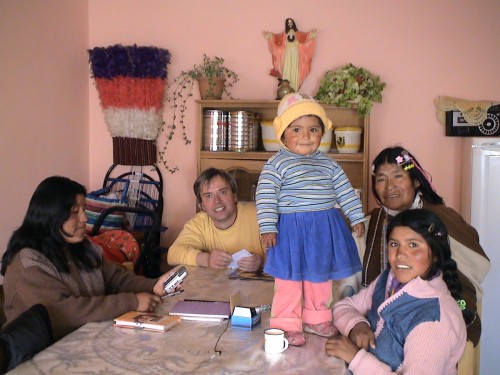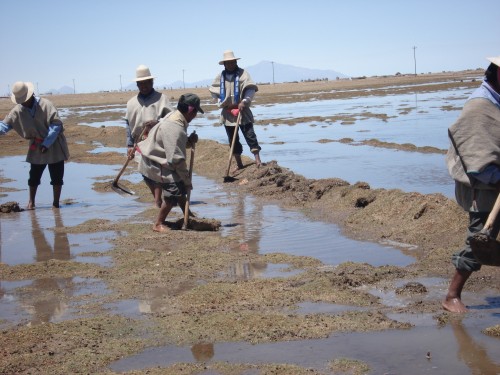The project was funded by the Volkswagen Foundation within the DOBES Initiative as a dissertation project called “Satz- und Textstrukturen im Chipaya” (Sentence and Text Structures in Chipaya). It is supervised by Prof. Dr. Fritz Serzisko at the University of Cologne. In Bolivia the project was realized in cooperation with and with the support of the Centre for Ecology and Andean Peoples in Oruro (CEPA) and the Museum of Ethnology and Folklore in La Paz (MUSEF).
The main goal of the project was to create a corpus of spoken Chipaya, consisting of audio and video recordings annotated with transcriptions, translations and analyses. For this purpose one team member, Francisca Condori Mollo, who is a native speaker of the language and student of anthropology, conducted interviews with several consultants from Santa Ana de Chipaya, most of them with an ethnographic content. The corpus of Chipaya consists of four major thematic units and several additional interviews on various themes:
Sebastiana Quispe and the film “Vuelve Sebastiana”
In 1953 Jorge Ruiz, one of Bolivia’s best-known filmmakers and pioneer of the Bolivian documentary film produced his most popular film called “Vuelve Sebastiana”. The film is a semi documentary presenting the culture of the people of Chipaya by telling the story of a girl who leaves the community for the neighboring Aymaras as she was impressed by their wealth. Her grandfather searches for her and convinces her to return to the people and the culture she belongs to. The film won several international awards and is still well known by most Bolivian people. Nevertheless very little was known about Sebastiana Quispe, the girl who played the leading part in the film and who by 2008 had reached the age of 65 and had become a grandmother. Francisca Condori conducted interviews with her over roughly 20 sessions. She was interviewed about her life, her memories of the movie, the input of the film on her life and on the life of the village. She also discussed various aspects of the culture of the Chipaya and changes that occurred during her lifetime.
A break during the interview sessions, with Sebastiana Quispe, her daughter and her granddaughter
Chipaya alphabet
Francisca Condori left the village of Chipaya before the official alphabet of the language was introduced, and was therefore not acquainted with it. Hence we asked a member of the local community who had worked in the process of creating the alphabet to give her a course in how to use it. This course was recorded and is part of the corpus.
The role of water in the culture of Chipaya
The people of Chipaya define themselves as “qhaś źoñi”, people of the water. Francisca Condori conducted interviews with various members of the community trying to investigate all the aspects that water has for the people of Chipaya, e.g. use for irrigation and desalinization, rituals for the deities of water, role in oral traditions etc.
Men from Chipaya flooding their land for desalinization
Ritual for the Lauca River
Every year on 6th of January the moiety of Manasaya practices an offering ritual to the Lauca River, asking for fertilization of their lands. In 2012 the project team was allowed to document this ritual and several interviews about this ritual have been conducted.
Chipaya people celebrating the offering ritual for the Lauca River on 6th of January 2012
Work with other Uru-Chipaya communities
In the beginning of the 1980s the French linguist Liliane Porterie Gutiérrez recorded words, phrases, numbers and three little texts with one of the last speakers of the language variety spoken in the village of Irohito. In collaboration with the MUSEF in La Paz we digitalized these recordings and were able to translate and transcribe them with the help of our Chipaya consultants. The people of Irohito helped us to understand the toponyms which were not known by the Chipaya consultants. These recordings have been incorporated into our corpus. Additional interviews were made about the culture and economic situation of Irohito.
Some interviews were made with Daniel Mauricio Choque, a member of the community of Puñaca Tinta María on the north eastern shore of Lake Poopó. He explained to us fishing and hunting techniques used by the people of his community. He gave us some words of Uru-Chipaya origin used for fishing and hunting instruments but claimed that the original language spoken by the Urus of Lake Poopó was another language called “Chholo”. For a more detailed discussion on this topic please confer:
Schumacher, Achim; Nathalie Böcker and Francisca Condori Mollo
2009 Chholo. In: Mily Crevels and Pieter Muysken (eds.): Lenguas de Bolivia, tomo 1, pp. 117-123.
La Paz: Plural editores.
What still can be done
Due to the limited resources of our project we are far from covering all aspects of the culture and language of the people called Uru-Chipaya (if that is possible at all). We would like to invite all investigators working with these people to contact us, add their information to our archive and help preserve them for future generations. Especially all recordings of the nowadays vanished varieties of the Uru-Chipaya language group would be highly interesting to save and investigate.
There are several other groups of Uru origin that are mentioned in the literature, but which have never been in the focus of investigation, e.g. the Uru-Capillus or the former Uru communities around Lake Titicaca, like Ch’imu. Investigations into their culture and into potentially still preserved knowledge of their ancestral languages may be interesting.





